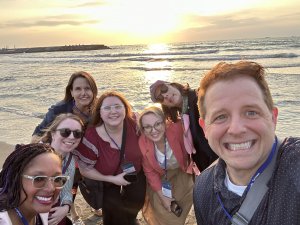My wife and I moved to Taipei with a certain amount of trepidation. The benefits were clear: she could take time off work to learn Chinese and all the materials that I would need to finish my dissertation were available. Yet it was a nerve-wracking prospect to spend nearly a year away from our dog, whom my father-in-law is looking after, in a place where only one of us spoke the language and neither of us had been. Now, ten months later, it was proven to be one of the best choices we could have made. We had heard Taiwan was an easy place to live, but had not realized it would be easier than anywhere we had lived before. Between the friendliness of the people, the ease of transportation, the cost of living, and the abundant access to work materials, it has been more pleasant than we could have imagined.
Most of my time this year has been spent working on my dissertation. The wide-ranging and easily accessible materials at the Institute of Chinese Literature and Philosophy at Academia Sinica allowed me to go from just two chapters to a full dissertation. The desk they provided and my extremely helpful advisers and coworkers also significantly contributed to the enormous progress I made this year.
In spite of all the time I have had to spend on research, we have also had the chance, over the holidays and when friends visited, to enjoy some of the recreational aspects of life in Taiwan. In these moments as tourists, we have been able to experience a small portion of what Taiwan has to offer. The pleasure we got from these excursions was all the more astonishing given how much we could do with only a modicum of planning.
Our first opportunity to explore Taiwan outside of Taipei was a weekend trip to Kaohsiung in late November. Two quick easy hours on the high-speed rail found us 220 miles from Taipei on the southern side of the island. We did not go with any plan other than to see a new part of Taiwan.
We arrived at the Kaohsiung train station in the evening just before dinnertime and emerged into pleasant, cool weather. A quick taxi ride took us to our hotel near the waterfront. An evening stroll led us to the arts district, which in times past had been an industrial zone. I have always found repurposed industrial buildings quite intriguing, so we naturally gravitated toward the area, which is now peppered with art galleries and entertainment venues. Although most of the galleries were closed, a band was playing a live music show in one of the larger warehouses. We sat and listened for a while, before walking along the water and then to the subway. We found ourselves at a night market, where we ate candied sweet potatoes, shrimp in quail eggs, and extra crispy corndogs dipped in dried noodles. After a rousing round of whack-a-mole, we returned to our hotel for the evening.
The next day we made a trip to Fo Guang Shan, which I believe is the largest Buddhist monastery in Taiwan. Much of our time was spent wandering, eating the delicious vegetarian food, and looking at the many large statues. The complex proved to be a curious mix of ancient relics (they house a supposedly authentic relic of the Buddha) and of modern shrine (there is a polygonal room devoted to the Bodhisattva Guanyin that features hologram walls with the Bodhisattva lit up in bright colors).
On our final day in Kaohsiung (we were on the last train back to Taipei that night), we returned to the arts district. We visited the traveling Star Trek exhibition, took the requisite photos on the bridge of the Enterprise, and then went to the beach. We ate dinner at the largest mall in Taiwan (in fact, in East Asia). We jumped on a train and were home in just over two hours.
At the very end of 2013, my mother-in-law came to visit. As is often the case, it is not until guests come into town that one gets around to seeing many of the tourist attractions. On New Year’s Eve, we walked the two blocks from our apartment to the Sun Yat-sen Memorial Hall. From there, we had an unobstructed view of the fireworks set off from Taipei 101. The show was quite impressive, but also notable was the politeness of the crowd. Prior to the show, as everyone got into position, they sat down. Once the show started, everyone remained seated and courteous. The sheer number of people promised a chaotic scene, but it never materialized. I had never seen anything like it before.
The next day, on New Year’s Day, we took the train east of Taipei to Pingxi. Pingxi was a coal-mining town in the past. After the coal mines shut down, there was little economic activity until it became a popular place to set sky lanterns free (fang tiandeng 放天燈). In hindsight, we should have gone on a day that was not so auspicious, because the train was completely packed. Yet the ride through the forested mountains was beautiful, crossing canyons and rivers.
Pingxi and its surrounding small villages are quaint places. Traditional shops line either side of the railroad. The train moves through town slowly; the people who are gathered on the tracks move to either side to let it pass and then reconvene. Right at dusk, we arrived at Pingxi, where we purchased a sky lantern. As is the tradition, we painted our wishes on the sides and then set them into the night sky. After a meandering bus ride, we were back home.
The next several months returned to normal and work kept me very busy. A friend came to visit in February and we set off to see more of Taiwan. We went to Taroko Gorge, just outside of Hualien on the eastern coast of the island. Our stated goal for the visit was to catch a glimpse of the monkeys that inhabit the area. We took a taxi to the main visitor center and then a bus further into the park. The weather was crisp and the rain held off for most of the trip. We walked along the Swallow Cliffs and had lunch deep in the center of the park at Tianxiang. The beauty of the gorge itself was quite inspiring, but it seemed we might not accomplish our goal of seeing a monkey.
From Tianxiang we walked to the Baiyang waterfall trail. The trailhead was carved into the side of the cliff just off the main road. We feared we had missed it until we were almost right on top of it. The tunnel proved an optical illusion; it seemed short, maybe one hundred meters at most. We started walking through the darkness, wishing we had brought a flashlight. And kept walking. And walking. After five minutes and perhaps five hundred meters, we finally reached the end and emerged into sunlight.
The trail itself was well maintained, but numerous signs warned of rockslides. We encountered fresh evidence of a recent slide along a ledge forty meters above the river. The trail terminated at Water Curtain Cave. The cave, whose water curtain was formed by a spring that leaks through the roof of the cave, was too dark to explore. I walked into the mouth of the cave and around the first bend, but quickly turned back and headed down the mountain.
Halfway to the entrance tunnel, we spotted the monkey. It was sitting in a tree above the trail and appeared to be eating something. It chattered at us, and eventually we wandered away satisfied. By this time evening was falling, and it was time to board the last bus back to the train station. We walked back to Tianxiang, got on the bus, and returned to Taipei via train.
Though our excursions to other parts of the island have proven enjoyable, we have found we do not have to travel far from home for adventure. Some of the more enjoyable experiences we have had have simply come on evening walks near our apartment. A few months ago, we were walking east along Zhongxiao Road north of the Sun Yat-sen Memorial Hall where the new arena is being built. On a lark, we turned north just past the construction. Three hundred meters past the main road, we stumbled upon a small pond next to the remains of an old tobacco factory. We had arrived at Songshan Cultural Park. We walked along the water’s edge and turned around. Across the lake, the new high-rise buildings near Taipei City Hall tower behind squat apartment buildings. The impressive sight seamlessly combines the nature of the lake with old residential and new commercial Taipei.
The old tobacco factory, like the warehouses in Kaohsiung, has been converted into gallery space. Next to these are a brand new mall, a movie theater, and artists’ studios. The culture park has become a favorite destination for walks. Whether it is to see art house movies, to look at old industrial architecture, or to see an exhibition, it is always an enjoyable experience.
These experiences represent only small vignettes of our time in Taiwan, a period in which we have been able to participate in life in a new city and culture. The significance of the opportunity has not been lost on us. It was a privilege for me to be able to cap off a remarkably productive year professionally with disparate cultural activities. Though we return to the United States in just several short weeks, I know we will be back.





